I’ve been researching and chewing on this symbol from the Nordic Bronze Age for a few months now. Prevailing popular opinion has it that the symbol is either a (magic) mushroom or is evidence of the Old Saxon “Irminsul-as-depicted-on-the-Externsteine”, and indeed my initial research was in part spurred by the latter notion.
As we have it, the symbol is present on less than a dozen Nordic Bronze Age rock-carvings and razor handles, but is nevertheless present enough and shows enough variance in depiction to see that it was known to many artists along the coasts of the old Ingvaeonic tribes.
It appears in different sizes and shapes, sometimes in the hand of an anthropomorphic figure, sometimes free standing, but always in association with the “solar ship”; where it can be found in various parts of the ship including in place of the prow and/or the rudder.
The Mushroom?
Regarding the notion that the symbol depicts a mushroom, I’ll simply quote Richard Rudgely on the matter of the mushroom in Germanic culture and belief,
“The vast amount of European folklore compiled by Wasson and his wife on the fly-agaric and other mushrooms indicates that in many areas of the Continent there were taboos in place against the use of certain fungi, suggesting an ancient ritual role for them. Despite the great efforts of the Wassons, neither archaeological sites nor archival materials have yielded up sufficient proof of such a cult”.
(The Encyclopedia of Psychoactive Substances)
The Irminsul?
Regarding the notion that the symbol is a Nordic Bronze Age depiction of the Irminsul, and so validates the notion that it is the Old Saxon Irminsul that is depicted on the Externsteine; well, to start, at least 2,000 years separate the Nordic Bronze Age symbol from the Extersteine relief with little to no intervening evidence to suggest a continuous tradition of the symbols use.
I personally, in my 30 years as a Germanic Heathen, have never bought into the notion that this image depicted the Irminsul; which IMO would more likely have resembled a Slavic god-pole or a Roman Jupiter column. The image on the Extersteine is simply “out of place” in the broad spectrum of Germanic symbolism; though admittedly the Nordic Bronze Age symbol might give one pause to wonder.
At this point, it would suffice to say that my opinion of the Extersteine image is that, whatever the “bent palm-tree” was meant to depict, ie. the Saxon Irminsul for example, that the actual Saxon Irminsul that was cut down by Charlemagne did not look like this image. People can of course fill a symbol with whatever content they want, regardless of it’s “original content”, and that is fine and dandy, but in terms of education there is always the matter of integrity.
So what then?
As alluded to above, symbols have little to no inherent meaning, and rely on culture and context to give them content. It is not enough to ask what does this symbol mean to me, or us here today? Nor even what might it have meant to a 10th century Saxon monk. A Bronze Age symbol must be understood within the context of the Bronze Age, which of course leaves us at a severe disadvantage as we are limited solely to the physical/archaeological record for anything even vaguely resembling a first hand reckoning of Nordic Bronze Age culture; though we do have the broader context of Proto-Indo-European ancestry and better represented Bronze Age relations to make up for this lack.
We might also care to remember that symbols can “layer” meaning in culturally idiosyncratic ways that allow for (and even encourage) a range of interpretations. They are not the product of analytical reductionist thought, but of a more expansive and poetic form of thinking.
Before looking at the evidence of the Nordic Bronze Age itself, we might take a gander at their Neolithic ancestors and Bronze Age relations, for any light these cultures might hope to shed on the matter.
The following images (below) were found etched into the rocks that make up the solar megalith of Stonehenge. They are believed to have been put there in the Bronze Age, long after Stonehenge’s construction, and are commonly regarded as upward turned axe-heads of the variety common to Bronze Age Britain; who’s people were of both Proto-Indo-European stock and engaged in trade with southern Scandinavia over the course of the Nordic Bronze Age.
The axe, particularly the double-headed ax or labrys, was also a prominent symbol among the Mycenaeans and Minoans; the former of whom, like the Celts of Bronze Age Britain, shared both a common Proto-Indo-European and carried on trade with the folk of the Nordic Bronze Age. Here we find the labrys depicted between the “horns of the Minoan bull” … otherwise known as the “horns of consecration”,
If I understand it correctly, it would only be later in hidyotu that the labrys would also take on an association with the lily, ie. layered meaning, depictions of which bare an even stronger resemblance to our Nordic Bronze Age symbol. Also, both axe and lily are often accompanied by solar imagery, not unlike the presence of the axe-head on the “solar symbol” that is Stonehenge itself.
What relation our Nordic Bronze Age symbol might have to the Minoan lily is a line of research that will have to wait for another time and/or person. From here on I will focus on it’s relation to the axe.
It is a curious fact that the evolution of Nordic Bronze Age culture began with the arrival of, not simply that culture dubbed the “Battle Axe People” in southern Scandinavia, but rather of a sub-category of that culture known as the “Boat-Axe People” in the late Neolithic era. These people were called so as a result of the boat-like shape of the axe-heads they produced. The relationship of the axe to the boat is of course inherent; as trees were felled and boats shaped via the use of axes and axe-head-like tools.
Curiously, examples of our Nordic Bronze Age symbol always occur in direct relation to the boat, and often in relation to solar imagery (other than the boat itself).
In the late Neolithic era the tribes of southern Scandinavia also wore axe-heads made amber as ornamentation; or perhaps (more likely?) as charms similar to the much later “Donar’s Cudgel” and “ThorR’s Hammer”.
Note the double-headed axe head in the image below. Despite the prominence of the labrys among the Mycenae, we don’t find these during the Nordic Bronze Age. We do however find plenty of dual imagery, axes being no exception, in both the art and deposits of the Nordic Bronze Age, much of which is associated with the cult of the Sun and her brothers, the Divine Twins.
Following this trail on into the Nordic Bronze Age itself, one cannot help but be immediately struck by the similarity of our subject symbol to this ceremonial axe-head. I’ve rotated the image for ease of comparison.
Excessively large axe-heads, far bigger than would be at all practical for combat, and so which are believed to have had a ceremonial purpose, not unlike the Minoan labrys, have in fact been unearthed in Scandinavia; thus confirming such rock carvings as the following,
We again see a reflection of our subject symbol (below) in one of the very peculiar, ie. stylistically, Kivik stones ( c.1,000 B.C.), where we find what appears to be twin axe-heads depicted in association with the sun-wheel.
These two youths (below), the Divine Twins, are found on the Fogtdarp yoke. A direct comparison can be drawn between them, the twin Grevensvaenge figurines and the Vikso helmets. They are all from the Nordic Bronze Age.
In Kristian Kristiansen and Thomas B. Larsson’s excellent work, “The Rise of the Bronze Age Society”, a bird’s eye view is provided of the top of their helmets (below), where we find our subject symbol set between the horns of their helmet and mention is made of it’s Mycenaean parallel in the labrys set betwixt the horns of the bull.
Our next image is a drawing of the Nordic Bronze Age’s Grevensvaenge twins; yet another Nordic Bronze Age depiction of the “Divine Twins” as seen in the rock art and testified to in the dual or twinned offerings — of axes, swords, lur horns — of the era. The basic idea of these brothers is expressed in the Latvian word jumis meaning “two grown together as one” … each holding a half of the elder double-headed axe?
When thought of in terms of the concept of jumis, one might also note the ceremonial swords of the Nordic Bronze Age, deposited as pairs, with curling tips quite reminiscent of our subject symbol when taken together as a whole.
While best represented in Migration and post-Migration Age lore as the sons of Woden, the Divine Twins are more roundly remembered in the broader Indo-European context as the offspring of the Skyfather (Zeus, Dyaus, Dievas, etc), who’s name and attributes are reflected in the Germanic Tiwaz (Tiw, Zio, TyR, etc.). It is at least curious to note the shape of his rune-stave (below) in the elder futhark in relation to our subject symbol.
While the etymology of the Germanic word heaven is open to debate, it is interesting in this context to note that Watkins “derives it elaborately from PIE *ak- “sharp” via *akman- “stone, sharp stone,” then “stony vault of heaven.” (Online Etymology Dictionary). We are reminded at once of the characteristic Proto-Indo-European stone battle axe, and of course of the stony skull of Ymir from Viking Age Nordic myth, where it was said to be used to form the roof of the heavens. In Greek legend the stony skull of Atlas comes to form of the mountain summit; while Indo-Iranian myth also (more loosely) associates the skull with the heavens and the divine.
Anyway, this same P.I.E. root (also) yields the Proto-Germanic *hamaraz (hammer) and various other Indo-European words with a range of meanings that include “anvil, pestle, battering ram” (Greek), “stone, hammer, thunderbolt” (Sanskrit), “sky, heaven” (Persian).
This of course calls to mind the famous hammer of the Viking Age North Germanic peoples. Rotated (below) for ease of reference, of course. It is worth noting that the Balto-Slavic Thunderer, Perun to use the Slavic, plays a strong role in their solar mythology. Their names are suspected to be etymologically related to the Old Norse Fjorgyn (fem.) and Fjorgynn (masc.), the former of whom is said to be the mother of Thunor (Donar, ThorR) in the Eddic myths. I interpret this as the seemingly obvious; that Thunor is the uniquely Germanic heir to the older “Fjorgynn”.
Whatever the case, Thunor is one of the very few deities who are portrayed as driving the patently anachronistic (sun) chariot. The other chariot-drivers of Eddic myth are Freo (Freyja) — who shares solar associations, indirectly, via her (twin) brother Ingui-Frea (FreyR) and the pig — and of course the “time-keeping deities” so central to the “sun-cult” (Sun, Moon, Day, Night). It is also Thunor who was believed to force the Wulf to disgorge the Sun during a solar eclipse, while his wife, Sif, is said to have had hair as brilliant as gold.
All-in-all, it would seem that our subject symbol was related to such notions as heavenly authority, hollowing power, and protection.
Certainly, there is no way of knowing, positively, what the symbol might have meant, let alone the extent of it’s meaning. And to some this might strike one as due leave to consider all opinions to be equally valid. Of course, with due respect to the theory of it all, I will say this … it was educated guessing, and not idle speculation (or absolute certainty), that put mankind on the moon.
Reckon wisely, my friends!

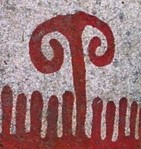





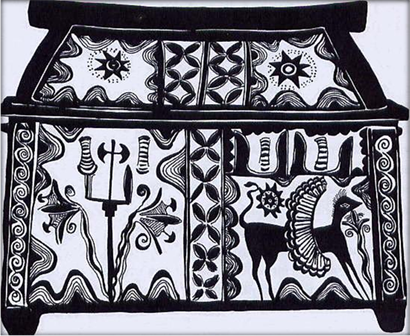
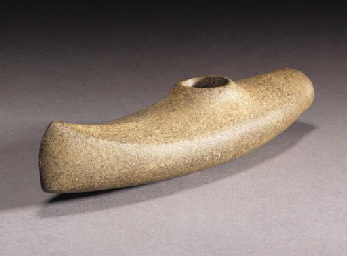
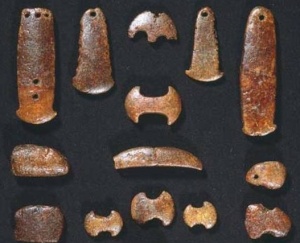


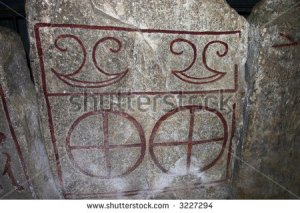
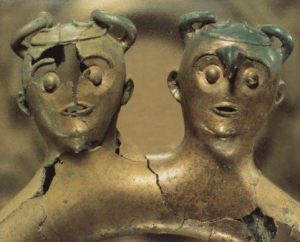


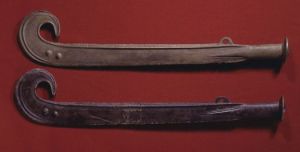


I love reading your posts. You’re the exception to my rule that I take no one seriously who makes grammatical errors (i.e. its vs. it’s).
LikeLike
LOL!!! My fiance is constantly correcting me on its/it’s. Bad habits die hard, I guess.
Thanks for the compliment, mate!
LikeLike
Reblogged this on Die Goldene Landschaft.
LikeLike
Interesting article – I never thought of an axe as the object on the boats, but it makes sense.
LikeLike
Pingback: The doubefaced figure from Thy | Tiwisko
Pingback: Paralleller mellan rakknivar och hällristningar | Brons och blod
https://oding.org/index.php/religion/irminsul-irrtum/1906-irminsul-wie-sah-sie-aus
Irminsul – Wie sah sie aus ?
LikeLike